Related Research Articles

Abarth & C. S.p.A. is an Italian racing- and road-car maker and performance division founded by Italo-Austrian Carlo Abarth in 1949. Abarth & C. S.p.A. is owned by Stellantis through its Italian subsidiary. Its logo is a shield with a stylized scorpion on a yellow and red background.
Osella is an Italian racing car manufacturer and former Formula One team. They participated in 132 Grands Prix between 1980 and 1990. They achieved two points finishes and scored five world championship points.
The European Sportscar Championship was a name used by several sports car racing championships based in Europe. Initially created in 1970 by the Fédération Internationale du Sport Automobile (FISA) as the European 2-Litre Sports Car Championship for Makes, the series increased in popularity and eventually became part of the World Sports Car Championship in 1976 even after a troubled 1975 season. Only two years later, as interest in sports-prototypes faded, the championship was downgraded from World Championship status and a European championship returned once more, only to be cancelled after its sole 1978 season.
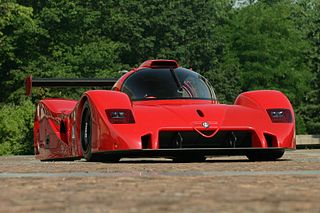
The Alfa Romeo SE 048SP was a Group C racing car built by Alfa Romeo in the early 1990s. Designed to replace the Lancia LC2 after the Group C regulations had undergone a major revamp, the SE 048SP had an Abarth-developed chassis mated to the 3.5-litre V10 engine from the stillborn Alfa Romeo 164 Procar, but, although at least one SE 048SP was built, it never left the development phase. The V10 engine appears to have been replaced by a Ferrari-sourced 3.5-litre V12 engine at some point during its development, although this was never officially confirmed by Alfa Romeo.

Vincenzo "Enzo" Osella is an Italian former racing driver and team owner. He is the founder and chairman of Italian auto manufacturer Osella. The team competed in Formula One between 1980 and 1990.

Nicola Materazzi was an Italian mechanical engineer who developed several sports and racing cars, including the Ferrari 288 GTO, Ferrari F40, Bugatti EB110, and B Engineering Edonis. He was one of Italy's leading turbocharging specialists from the mid-1970s, a respected sports car and motorcycle engineer, and is sometimes referred to as "Mr. F40" or the "father of the F40."

Abarth 2000 Sport (SE010) is an rear-engined racing car built by Italian car maker Abarth, which won its class at the 1000 km of Monza in 1971 and finished 11th overall. It was homologated for FIA Group 4 on 1 April 1969 with homologation number 252, and participated in a number of car races from 1969 to 1973. At least 50 cars were constructed, including the Sport SE mid-engine variant (SE014/019).

The Fiat Abarth 1000SP is a Group 4 and Group 6 sports racing car built by Abarth in 1966 and 1970.

The Abarth 3000 Sport Prototipo was a sports car prototype made by Abarth & C. in Turin, Italy. It was the first Abarth with an engine with a capacity of more than 2-liters, after an already finished 6-liter twelve-cylinder from 1967 had become useless before it could be used due to a change in the regulations. The displacement for sports car prototypes was limited to 3 liters and for sports cars to 5 liters.
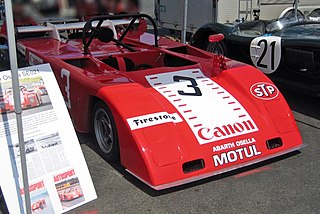
The Abarth-Osella 2000 Sport SE-021 is a mid-engined, Group 5, prototype race car, built by Osella to compete in the World Sportscar Championship sports car racing series in 1972, and for some races in 1973. The chassis itself was developed and developed by Osella, while the car itself was powered by a 2.0 L (120 cu in) Abarth four-cylinder engine, generating a healthy 265 hp (198 kW). Since the light and nimble chassis only weighed 530 kg (1,170 lb), this gave it an incredible power-to-weight ratio. It was entered 39 times in races, and had 10 podiums. It scored 8 wins in its career.
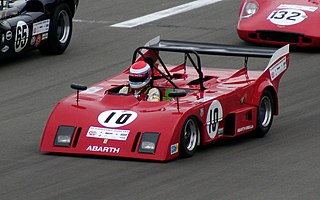
The Abarth-Osella PA1 is a 2-liter Group 5 prototype racing car built by Osella in collaboration with Abarth, to compete in the World Sportscar Championship sports car racing series in 1973, but was used in active competition through 1982.

The Osella PA3 is a Group 6 prototype racing car designed, developed, and built by Osella, to compete in the World Sportscar Championship sports car racing series in 1975, but was used in active competition through 1986. It was powered by a number of different engines, including the 2.0 L (120 cu in) BMW M12/7, the Abarth twin-cam engine, and the Cosworth BDG, or the 1.3 L (79 cu in) Cosworth BDH, or even the smaller 998 cc (60.9 cu in) Cosworth SCA. The 1.6 L (98 cu in) and 1.8 L (110 cu in) Cosworth FVA and Cosworth FVC were also used. It was even powered by a Ferrari 2.0 V8 engine. It scored a total of 13 wins, and 25 podiums. It was entered 103 times during its career.
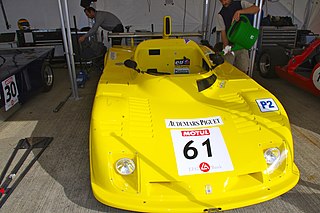
The Osella PA4 is a Group 6 prototype racing car designed, developed, and built by Osella, to compete in the World Sportscar Championship sports car racing series between 1976 and 1980. It was powered by a number of different engines, including the 2.0 L (120 cu in) BMW M12/7, and the Cosworth BDG. The 1.6 L (98 cu in) and 1.8 L (110 cu in) Cosworth FVA and Cosworth FVC were also used. It was even powered by a Ferrari 2.0 V8 engine. It scored a total of 8 wins, and 18 podiums. It was entered 82 times, to various different racing events.

The Osella PA5 is a Group 6 prototype racing car designed, developed, and built by Osella, to compete in the World Sportscar Championship sports car racing series between 1977 and 1981. It was powered by a number of different engines, including the 2.0 L (120 cu in) BMW M12/7, Hart 420R, and the Cosworth BDG. The 1.6 L (98 cu in) and 1.8 L (110 cu in) Cosworth FVA and Cosworth FVC were also used. It was even powered by a Ferrari 2.0 V8 engine.

The Osella PA6 and Osella PA7 are Group 6 prototype racing car designed, developed, and built by Osella, to compete in the World Sportscar Championship sports car racing series between 1978 and 1982. It was powered by a number of different engines, including the 2.0 L (120 cu in) BMW M12/7 and the Cosworth BDG, and the 1.6 L (98 cu in) Cosworth FVA was also used. After retiring from sports car racing, these cars later competed in hillclimb racing.
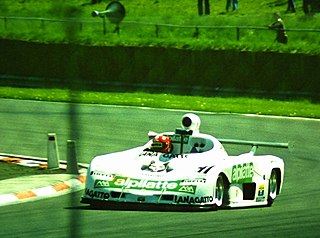
The Osella PA8 was a 2-liter, Group 6, sports car prototype, developed by Osella Squadra Corse in 1980, and used in sports car and Hillclimb races until 1988. It is powered by the naturally aspirated, 300 hp (220 kW), 2.0 L (120 cu in) BMW M12/7 engine, drives the rear wheels via a 5-speed Hewland LGA manual transmission.

The Osella PA9 was a 2-liter, Group 6, sports car prototype, developed in 1981 by the Turin racing car manufacturer Osella and used by the factory in sports car and hill climb races until 1988.

The March 84G was a mid-engined Group C and IMSA racing sports prototype, designed and developed by March Engineering in late 1983 and used in sports car racing until 1989. It was powered by a number of different engines, including a Chevrolet small-block, a Buick V6, a Porsche flat-six, and even a Mazda 13B Wankel rotary engine. Power output was around 620 hp (460 kW). It only managed to score 5 wins, and clinch a total of 10 podium, over the course of 7 years and 119 race entries.

The Osella PA21 is a series of Group CN sports prototype race cars, developed and built by Italian manufacturer Osella. The cars mostly compete in hillclimb races, trials, and events. They are commonly powered by, and designed to be equipped with either a naturally-aspirated 2.0 L (120 cu in) Honda K20 engine, producing in excess of 250 hp (190 kW), or a motorcycle engine, in the displacement range of 1.0–1.6 L (61–98 cu in), such as a Suzuki Hayabusa, or an S1000RR motor.

The Chevron B16 was a Group 4 sports prototype race car, designed, developed, and built in 1969 by the British racing car manufacturer Chevron Cars as a two-seater racing sports car for the makes world championship. Brian Redman won the very first outing, the 500 km (310 mi) race at the Nürburgring on September 7, 1969, at a time of 3:13:01.6 hours. The last victory with a Chevron B16 was achieved by Clemens Schickentanz on July 11, 1971, in the sports car race at the Norisring.
References
- ↑ "Bonhams : 1974 Abarth-Osella PA2 Sports Prototype Chassis no. PA2-013". www.bonhams.com.
- ↑ "Abarth-Osella PA2 results" . Retrieved 17 June 2022.
- ↑ "Abarth-Osella PA2 archive" . Retrieved 17 June 2022.
- ↑ "Osella PA2 group 5 (1974) - Racing Cars". tech-racingcars.wikidot.com.
- ↑ "Abarth-Osella PA2 (1974)".
- ↑ "1983 Osella PA2/2000". www.classicdriver.com.
